Kitum Cave, located in Mount Elgon National Park, Kenya, is a perfect spot for wildlife enthusiasts to observe various species up close. However, it is also believed to be the origin of the deadly Marburg virus, which has led to the deaths of infected patients.
Is Kitum Cave Home to the Most Dangerous Viruses in the World?
Dubbed one of the five “elephant caves” of Mount Elgon, Kitum Cave stretches approximately 700 feet (about 213 meters) into the mountainside. The cave walls are rich in salt deposits.
Kitum Cave is considered one of the most dangerous caves on the planet due to the presence of the Marburg virus, which is lethal, similar to the Ebola virus. Marburg virus outbreaks cause hemorrhagic fever and other severe symptoms, ultimately leading to the death of infected patients!

The Marburg Virus (Marburg Virus Disease – MVD) is an RNA virus belonging to the Filoviridae family, the same family as the Ebola virus. This virus is transmitted from animals to humans, causing hemorrhagic fever and severe bleeding in various parts of the body.
Two cases of death from the Marburg virus in the 1980s raised suspicions about Kitum Cave being a reservoir for this deadly virus.
The first case occurred in 1980 when a French engineer working at a sugar factory near the base of Mount Elgon ventured into Kitum Cave. His cave visit turned into a nightmare as he developed severe symptoms and had to be hospitalized in Nairobi. Ultimately, he died.
Another fatality was recorded in 1987 when a Danish boy explored Kitum Cave during a family vacation. This boy also died from the Ravn virus, a virus closely related to the Marburg virus.
The Terrifying Expedition of USAMRIID to Identify Deadly Virus Vectors
Based on the aforementioned cases, the United States Army Medical Research Institute of Infectious Diseases (USAMRIID) organized an expedition to the cave in an effort to identify the viruses believed to reside in Kitum Cave.
Scientists suspected that bats inhabiting the cave might have transmitted the virus to humans. They collected samples from various species, including fruit bats, to determine if the suspected disease vectors could be found in these animals. However, the Marburg virus was not found. Therefore, the source of this virus remains a mystery.

The original host of the Marburg virus is the African fruit bat, scientifically known as Rousettus aegyptiacus. Infected fruit bats show no clear signs of illness, making them hard to identify. However, primates (including humans) that become infected can develop severe symptoms and have a high mortality rate similar to that of Ebola.
The bestselling book, “The Hot Zone (1994)” by author Richard Preston, describes real events surrounding the Ebola virus outbreak in the late 1980s. He also provides details about other viral outbreaks in Africa during the 1970s and 1980s. His book recounts the experiences of visitors to Kitum Cave, including his own journey to this life-threatening location.
In 2007, similar expeditions were conducted in mines in Uganda and Gabon when two miners contracted the Marburg virus. Concrete evidence of the reservoir for the Marburg virus was found in the fruit bats inhabiting these caves. Interestingly, the mining areas in Uganda have populations of African fruit bats similar to those found in Kitum Cave! This suggests that the bats and bat droppings were indeed the long-sought vectors in Kitum Cave. Notably, neither of the miners infected with the Marburg virus in 2007 were bitten by any bats. This indicates that the virus spread through inhaling bat droppings in powder form!
Uncovering the Truth Behind the Mysterious Signs of Kitum Cave
When Kitum Cave was discovered, it had many scratches and grooves along its walls. These marks were initially believed to be the result of ancient Egyptians digging into the cave walls in search of gold, diamonds, and other precious stones. However, the real reason turned out to be something quite unusual.
Every night, hundreds, even thousands of wild animals enter the cave to lick the salt deposits on the cave walls. These animals include elephants, buffalo, baboons, leopards, antelopes, and hyenas.

When elephants enter the cave, they often bump heads to find their way in. (Illustrative image).
When elephants enter the cave, they often bump heads to navigate their way inside. Additionally, they use their massive tusks to scrape away sections of the cave walls to chew and swallow the salt. As a result, over the centuries, scratches and indentations have appeared in the cave. Evidence of tusk marks has also been found on the cave walls. In fact, the size of the cave has significantly increased over the years due to these activities by elephants. Other animals visiting Kitum Cave consume the salt left behind by these elephants.
Exploring the cave is perilous, even for the animals visiting this cave. Younger and less experienced elephants may fall into the deep pits within the cave, leading to it becoming one of the elephants’ graveyards!





















































